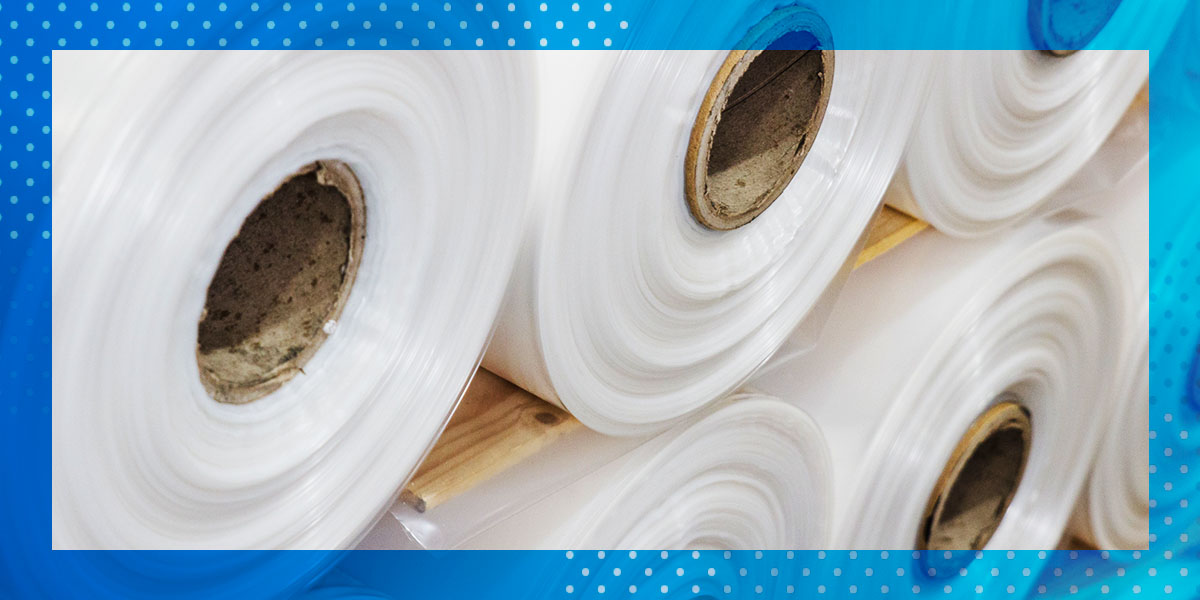Corrosion is one of the most pervasive challenges in any industry that deals with metals. Volatile corrosion inhibitor (VCI) packaging is a cost-effective, environmentally friendly solution. Anti-rust paper or bags protect metal products and equipment against corrosion in an enclosed space, eliminating the need for traditional protection methods like oil-based coatings.
It’s helpful to understand the science behind VCI packaging in order to fully appreciate and utilize this solution. This packaging is available in diverse forms and is prevalent in many industries that use it to maintain consistency with product quality. As a result, it’s easy to see why this solution is preferred over attempting to salvage corroded metal parts at an additional labor cost.
What Is VCI Protective Packaging?
VCI packaging options create an enclosed environment without altering metal properties to keep oxidation and associated reactions at bay. This protective material — also known as vapor corrosion inhibitor or vapor phase corrosion inhibitor packaging — is a poly packaging made with VCI molecules and proprietary AN-OX VCI chemicals. In terms of benefits, VCI packaging is easy to use and helps protect equipment and components.
VCI packaging works by forming a thin, almost invisible surface layer akin to kraft paper that combines with the chemical compound of VCI to give products adequate protection against water, oxygen, salt and other contaminants that facilitate the corrosion process. It protects metallic items like engine molds, engines, metal components and machined parts during long-term storage and shipping. This chemical compound does not affect the composite, electrical or optical components it protects.
In addition, VCI packaging is not hazardous to workers. These chemicals pose some risk in their raw state, but after processing and applying them to packaging materials, employees do not need protective gear when handling them.
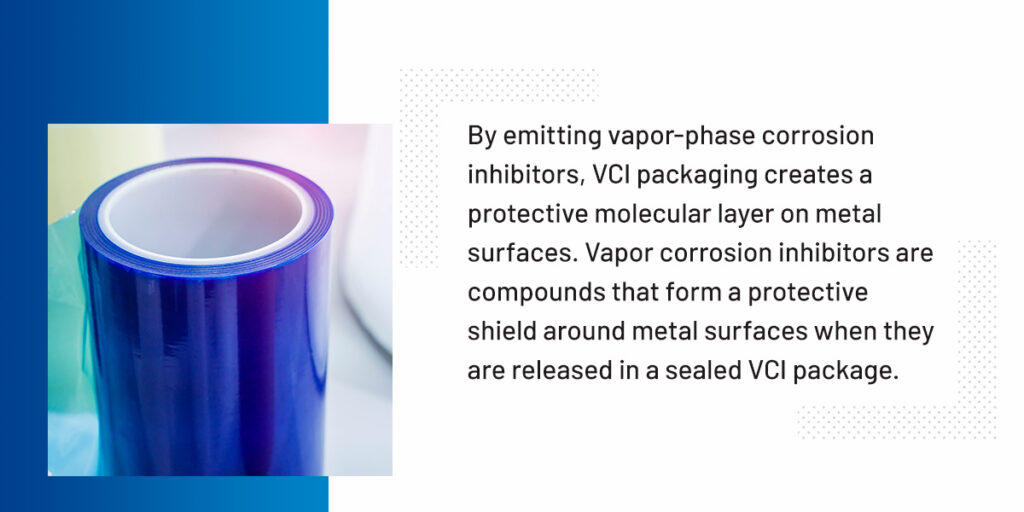
How Do VCIs Work?
Corrosion is an anodic and cathodic reaction that is co-occurring as metal ions move through a metal structure. When the surface of a metal is exposed to moisture and oxygen, it triggers an electrochemical process, gradually breaking down or weakening the metal’s integrity, leading to rust formation.
By emitting vapor-phase corrosion inhibitors, VCI packaging creates a protective molecular layer on metal surfaces. Vapor corrosion inhibitors are compounds that form a protective shield around metal surfaces when they are released in a sealed VCI package. This shield is a powerful deterrent against corrosive elements that disturb metal’s integrity.
VCIs reduce labor time and hazardous waste disposal fees while offering the additional benefit of protecting equipment with intricate internal parts, like pipes and valves. Equipment like this often poses a challenge in traditional rust-preventative coating processes. The characteristics of this VCI material work together to offer a thorough, easy-to-use and reliable source of protection for various metal types.
This packaging strategy can be completed without any oils or greases required. Once components are removed from the VCI packaging, the molecules evaporate, ensuring that machinery components and other equipment do not require cleaning before use.
What Metals Should Be Protected With VCI Packaging?
Ferrous metals that contain iron benefit the most from VCI packaging to fend off rust and corrosion. These metals are particularly vulnerable to rust as they have a high carbon content. This excludes wrought iron and stainless steel, which are protected by chromium within the metal. Ferrous metals include steel, cast iron, chrome, iron, alloy steel, carbon and more. These metals are typically seen in construction, shipping containers, industrial piping, transport and domestic applications.
Non-ferrous metals are malleable and corrosion-resistant as they do not contain iron. That being said, non-ferrous metals like copper, bronze, lead, silver, brass, aluminum, silver and certain multi-metals can also gain protection from VCI packaging.
Selecting the right VCI packaging depends on the metal or metal alloy that needs protection and the environmental conditions in which the metal is stored or transported. This is why customized VCI and anti-rust packaging is often the ideal option. Customizing this packaging according to your industry and applications helps the solution perform effectively and in alignment with specific requirements.
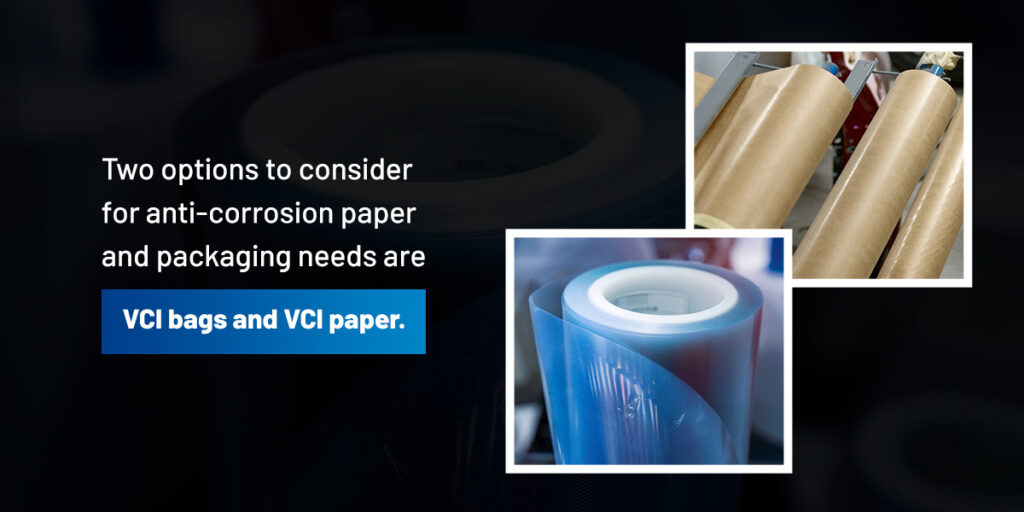
Types of VCI Protective Packaging
Using VCI packaging to protect specific metal components helps businesses mitigate the risk of corrosive damage to products, which in turn saves on overhead, labor and valuable time. Two options to consider for anti-corrosion paper and packaging needs are VCI bags and VCI paper. With similar functionalities, both materials offer unique characteristics and benefits, catering to various industry needs for short-term and long-term protective packaging.
VCI Bags
Transparent volatile corrosion inhibitor bags can be made using poly packaging film and adding VCI chemistry for rust protection benefits. They are available in various styles and feature different seals and inhibitors.
VCI bags come ready to be used and require no special training beyond standard best practices for handling. The protective nature of this product allows items stored within to be used immediately after unboxing.
A primary application for VCI bags is in cases where metal products are exported. Even so, they are used to meet a wide range of requirements across industries. Once metal parts and components are placed into the enclosed space of the bag, corrosion-inhibiting molecules are released to offer protection. The bags can also be heat-sealed to prevent any potential contamination.
VCI bags offer the following benefits:
- Long-term protection: VCI bags protect metal components against the effects of oxidation, which can last for an extended period. This feature is ideal for storage or shipping applications.
- Eco-friendly and reliable: These bags offer high dust and water resistance, adding to the long-term protection benefits. As a bonus, they are typically recyclable to support environmentally friendly practices.
- Wide range of options: These solutions are available in various sizes and can be customized to specific packaging needs. They are particularly useful for individual metal parts, more oversized items and small assemblies.
VCI Paper
VCI roll paper is helpful in protecting smaller components or irregularly shaped items. It can be used to either line boxes or wrap directly around metal parts. The protective corrosion inhibitors are released more quickly than in the case of bags, which is valuable for metals with a quick corrosion or flash rust vulnerability.
When the proper wrapping techniques are used, products placed within VCI rust inhibitor paper have instant protection. These are sheets of paper covered on both sides with water-soluble, high-tech VCI chemicals to protect ferrous, non-ferrous and composites from corrosion.
Additional benefits of VCI paper include:
- Many size options: VCI paper is available in a wide range of sizes to accommodate nearly any packaging need.
- Sustainable and cost-effective: Anti-corrosion paper is biodegradable, which helps businesses reduce their carbon footprint. In addition, anti-rust paper may cost less compared to VCI bags.
- Effective protection: VCI paper sheets are an ideal solution for products that require frequent handling or inspections, as the paper is easy to remove and replace.
VCI Paper vs. VCI Bags
To decide between the two, start by answering the following questions to help in your decision-making process:
- What is the exact intended application?
- Where will the metal product be stored or shipped to?
- If shipped, how demanding is the shipping and handling process expected to be?
- Are there any packaging preferences that need to be considered?
VCI bags are easy to use, offer more durable long-term protection and create a sealed moisture barrier. VCI paper, on the other hand, provides more protection against flash corrosion and is an efficient solution for short-term metal component protection. Paper is also a more economical option and ideal for smaller products.
VCI paper and bags can also be used in tandem. For example, let’s say metal products will be exposed to intense temperature fluctuations or stored in high-moisture areas. VCI bags and paper can be used in conjunction for added component protection. The VCI paper will serve as a “carrier” or first line of defense — it can also be crumpled to offer additional in-bag protection. Then, the VCI bag offers additional support.
Utilizing both solutions is an effective strategy since metal products will enjoy the benefit of immediate protection along with long-term protection.
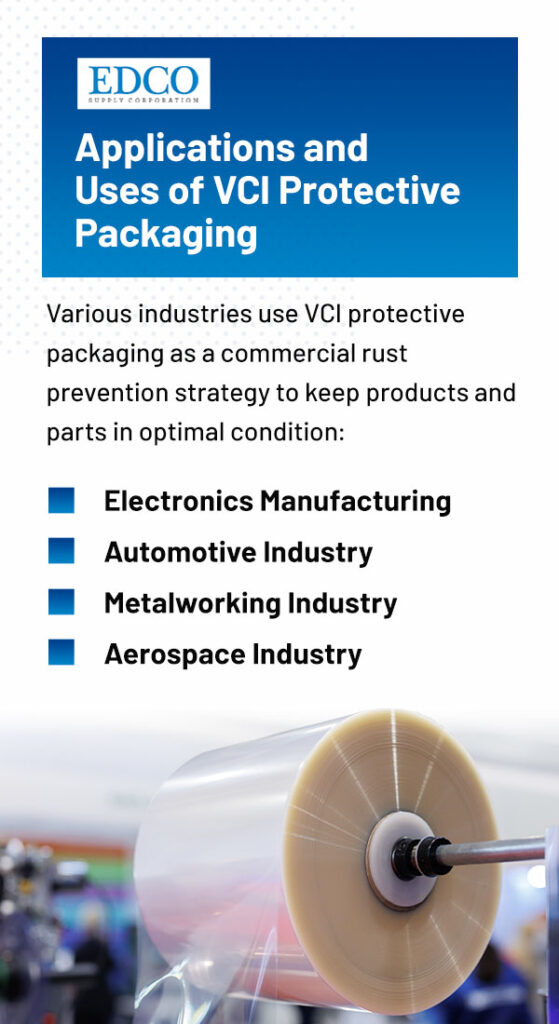
Applications and Uses of VCI Protective Packaging
Various industries use VCI protective packaging as a commercial rust prevention strategy to keep products and parts in optimal condition. The demand for VCI is growing significantly, with a market value prediction of $1.4 billion by 2033. This product is frequently used in the oil and gas, automotive, metalworking and aerospace industries, as well as electronics manufacturing.
Electronics Manufacturing
VCI packaging safeguards sensitive electronic components from corrosion during production, storage and transportation. Metal components like printed circuit boards, delicate microprocessors and connectors are susceptible to corrosion, which is not an easy fix when damage occurs.
Moisture poses another threat in electronics manufacturing, which is solved by using VCI bags that help control moisture levels around electronic components. By preventing corrosion and safeguarding these parts, VCI packaging adds to stakeholders’ overall efficiency and reliability in the electronics industry.
Automotive Industry
Corrosion during transport is a prevalent problem in the automotive industry. VCIs are used for long-term storage, shipping and transportation as well as exporting for long-distance shipping. Automotive repair shops may store spare components to offer replacement parts to clients and in the automotive aftermarket part industry — VCIs safeguard these items until they are ready for installation.
VCI protection is also invaluable in the case of pipelines. Pipeline corrosion inhibitors are either water- or oil-soluble. The water-soluble corrosion inhibitors, usually ammonium compounds, are meant for pipelines that transfer water. Oil-soluble corrosion inhibitors, like organic amines or carboxylic acids, are applied to pipes transporting organic fuels, oil and gas. Doing so helps prevent rust and corrosion as various liquids pass between parts in a vehicle.
Metalworking Industry
Metalworking companies store components and parts for extended periods, and VCI protective packaging protects the surface integrity of these parts. It is also used to protect machinery against rust when not in use. Using this packaging solution ensures quality consistency of metal parts, reduces maintenance costs on equipment and decreases the need for additional labor to clean and rework components that have rust damage.
Aerospace Industry
Aerospace components like engines, landing gear, avionics and structural parts are often placed in long-term storage between uses. In addition, precision tools, spare parts and maintenance equipment are susceptible to damage during storage. VCI packaging helps keep these parts and tools in optimal working condition.
Since the aerospace industry is particularly subject to strict quality standards, it benefits greatly from VCI packaging to ensure component integrity and help organizations meet regulatory requirements.
VCI Packaging Best Practices
To make the most of VCI packaging, it is essential to take specific steps that will protect the product’s integrity, keeping VCI vapors inside the packaging. Avoid cross-contamination by storing the packaging in an airtight container and following these guidelines:
- Keep metal away from wood and cardboard: Corrugated cardboard and wood are acidic, so they can induce and accelerate corrosion. Avoid having metal components directly in contact with wooden pallets or cardboard boxes.
- Store packaging appropriately: Keep VCI packaging in a cool, dry environment with little to no exposure to direct sunlight. Correct storage can help VCI products last for close to two years.
- Avoid overexposure: Do not leave the packaging open when wrapping metal components. Instead, work in small quantities, removing precisely what is needed for each use. Use a “first-in, first-out” practice.
- Clean components prior to packaging: Clean metal components before wrapping them in VCI packaging, as the protection offered works best on surfaces free of contaminants.
- Do not package damp or wet products: Corrosion can occur even inside VCI packaging when metals are packaged while damp or wet, nulling the effectiveness of this product. Ensure handlers wear clean cotton gloves when putting products into VCI packages, as hands can transfer acidity, moisture and oil.
- Package parts quickly: It is best to immediately transfer clean, dry metal parts into VCI packaging, avoiding dust and other contaminants from adhering to the metal surface.
Avoid using desiccants like silica gel in conjunction with VCI packaging or as added moisture absorption in storing the packaging itself. Desiccants are meant to draw in and retain moisture, but once they reach their absorption rate, they can actually release moisture back into the space.
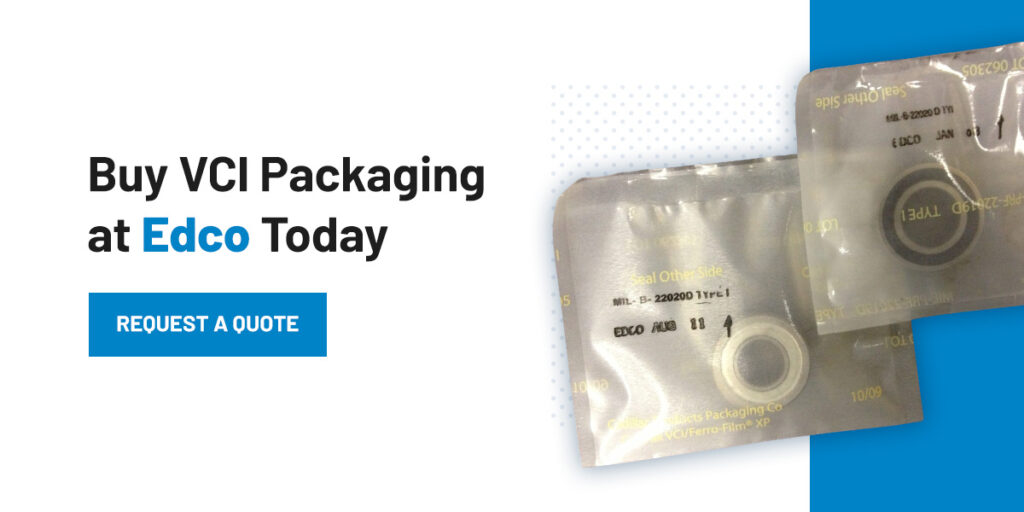
Buy VCI Packaging at Edco Today
VCI technology simplifies corrosion protection for metal components across various industries. Its ability to create a protective barrier, extend the longevity of metal items and inhibit rust formation helps various organizations cut costs and increase quality control over components and equipment. Whether for long-term storage or transportation, VCI protective packaging remains a reliable defense against the effects of oxidation.
Edco is the world’s leading supplier of mil-spec packaging, including VCI bags and paper. As a family-owned business, we have been dedicated to meeting customers’ protective packaging needs since 1954. We offer a comprehensive selection of in-stock products as well as fast lead times. Customizable sizing is available in small or large quantities to align with your specific VCI packaging requirements.
For more information about our VCI product options, request a quote or contact us today.


